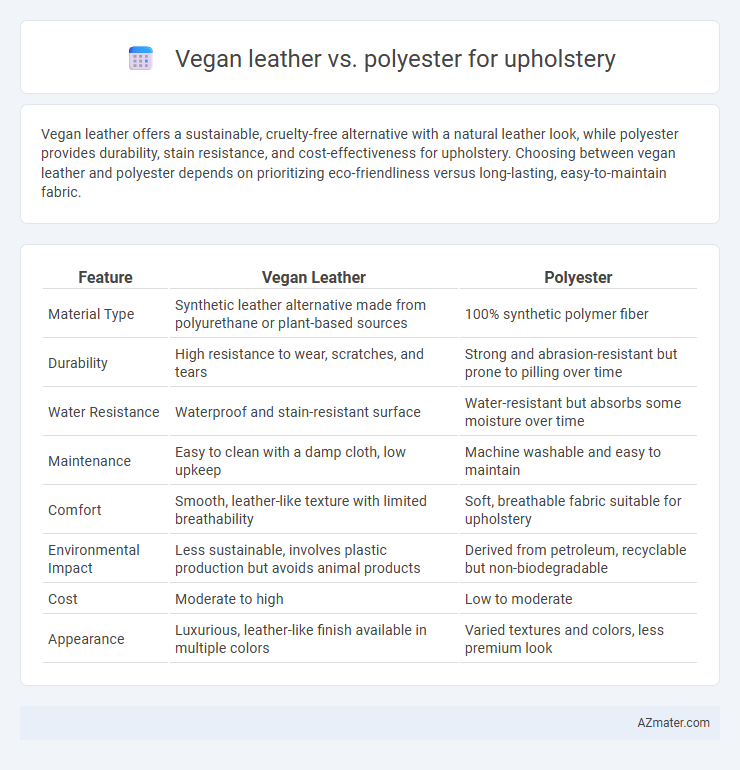Vegan leather offers a sustainable, cruelty-free alternative with a natural leather look, while polyester provides durability, stain resistance, and cost-effectiveness for upholstery. Choosing between vegan leather and polyester depends on prioritizing eco-friendliness versus long-lasting, easy-to-maintain fabric.
Table of Comparison
| Feature | Vegan Leather | Polyester |
|---|---|---|
| Material Type | Synthetic leather alternative made from polyurethane or plant-based sources | 100% synthetic polymer fiber |
| Durability | High resistance to wear, scratches, and tears | Strong and abrasion-resistant but prone to pilling over time |
| Water Resistance | Waterproof and stain-resistant surface | Water-resistant but absorbs some moisture over time |
| Maintenance | Easy to clean with a damp cloth, low upkeep | Machine washable and easy to maintain |
| Comfort | Smooth, leather-like texture with limited breathability | Soft, breathable fabric suitable for upholstery |
| Environmental Impact | Less sustainable, involves plastic production but avoids animal products | Derived from petroleum, recyclable but non-biodegradable |
| Cost | Moderate to high | Low to moderate |
| Appearance | Luxurious, leather-like finish available in multiple colors | Varied textures and colors, less premium look |
Introduction: Vegan Leather vs Polyester for Upholstery
Vegan leather, a synthetic alternative to traditional leather made from materials like polyurethane or recycled plastics, offers a cruelty-free and eco-conscious option for upholstery. Polyester, a durable and affordable synthetic fiber derived from petroleum, provides high resistance to stains and fading, making it a popular choice in upholstery applications. Comparing vegan leather and polyester reveals differences in texture, sustainability, breathability, and maintenance requirements essential for informed upholstery decisions.
Material Composition and Production Processes
Vegan leather for upholstery is typically made from polyurethane (PU) or polyvinyl chloride (PVC) layered on a fabric base, mimicking animal leather while avoiding animal products. Polyester upholstery, derived from synthetic polymers primarily polyethylene terephthalate (PET), is produced through polymerization of petroleum-based materials, offering durability and resistance to wear. The production of vegan leather involves chemical treatments to replicate leather texture and flexibility, whereas polyester manufacturing emphasizes creating strong, lightweight fibers through extrusion and weaving processes.
Environmental Impact and Sustainability
Vegan leather made from plant-based materials like pineapple leaves or cactus offers a more sustainable alternative to polyester, which is derived from petrochemicals and contributes to microplastic pollution. The production of vegan leather typically consumes less water and emits fewer greenhouse gases compared to the energy-intensive manufacturing of polyester upholstery fabrics. Choosing vegan leather reduces reliance on fossil fuels and supports biodegradable waste management, enhancing overall environmental sustainability.
Durability and Longevity
Vegan leather offers moderate durability with resistance to scratches and stains but may degrade faster in high-traffic areas compared to polyester. Polyester upholstery is known for exceptional longevity due to its strong fibers and ability to resist wear, fading, and mildew over time. Choosing polyester ensures greater durability for heavily used furniture, while vegan leather balances aesthetics with reasonable lifespan in lighter-use environments.
Comfort and Feel
Vegan leather offers a soft, smooth texture that mimics genuine leather, providing a luxurious and breathable feel ideal for upholstery in living spaces. Polyester upholstery, while durable and resistant to stains, often feels less supple and can become stiff, impacting overall comfort during extended use. The choice between vegan leather and polyester significantly influences seating comfort, with vegan leather providing a warmer, more natural touch compared to the synthetic feel of polyester.
Aesthetic Versatility and Design Options
Vegan leather offers a premium, natural look with textures mimicking genuine leather, enhancing upholstery aesthetics with rich, tactile appeal suitable for modern and classic designs. Polyester provides extensive color variety and patterns, allowing versatile customization but often lacks the luxurious texture of vegan leather. Choosing between vegan leather and polyester depends on desired design flexibility and the importance of authentic leather appearance in upholstery projects.
Maintenance and Cleaning Requirements
Vegan leather upholstery demands gentle cleaning with mild soap and water to avoid damage, and it should be wiped regularly to prevent dirt buildup. Polyester fabric is more durable and resistant to stains, allowing for more aggressive cleaning methods such as machine washing or spot treatment with household cleaners. Both materials benefit from routine maintenance, but polyester's stain resistance and ease of cleaning make it a low-maintenance option for high-traffic areas.
Cost Comparison
Vegan leather typically costs between $15 to $40 per yard, varying by quality and brand, while polyester upholstery fabric ranges from $5 to $20 per yard, making polyester generally more budget-friendly. The higher price of vegan leather is due to its sustainable materials and intricate manufacturing processes designed to mimic genuine leather's appearance and texture. Cost efficiency considerations should include durability and maintenance, as vegan leather often offers longer lifespan and easier cleaning, potentially offsetting its initial higher investment.
Health and Allergen Considerations
Vegan leather, often made from natural materials like polyurethane or cork, tends to be hypoallergenic and less likely to emit harmful volatile organic compounds (VOCs), making it a safer choice for indoor air quality. Polyester upholstery, a synthetic fabric, can sometimes trigger allergies or skin irritation due to its chemical treatments and potential off-gassing of formaldehyde or other toxins. Choosing vegan leather reduces exposure to allergens and toxic chemicals, promoting a healthier indoor environment especially for individuals with sensitivities.
Conclusion: Choosing the Right Upholstery Material
Vegan leather offers a sustainable and cruelty-free alternative with a luxurious appearance, making it ideal for eco-conscious upholstery projects. Polyester provides high durability, stain resistance, and affordability, suitable for high-traffic areas and budget-friendly designs. Selecting between vegan leather and polyester depends on prioritizing environmental impact, texture preference, and intended use of the upholstered furniture.

Infographic: Vegan leather vs Polyester for Upholstery
 azmater.com
azmater.com